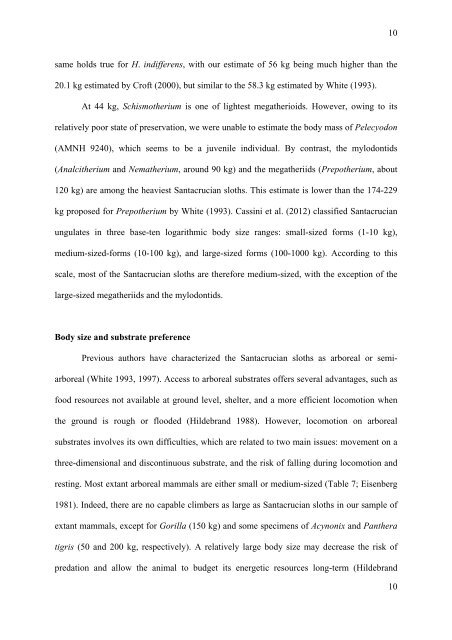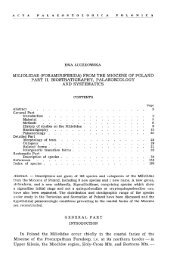Mass estimation in fossil sloths (Xenarthra, Folivora) from the Early ...
Mass estimation in fossil sloths (Xenarthra, Folivora) from the Early ...
Mass estimation in fossil sloths (Xenarthra, Folivora) from the Early ...
You also want an ePaper? Increase the reach of your titles
YUMPU automatically turns print PDFs into web optimized ePapers that Google loves.
same holds true for H. <strong>in</strong>differens, with our estimate of 56 kg be<strong>in</strong>g much higher than <strong>the</strong><br />
20.1 kg estimated by Croft (2000), but similar to <strong>the</strong> 58.3 kg estimated by White (1993).<br />
At 44 kg, Schismo<strong>the</strong>rium is one of lightest mega<strong>the</strong>rioids. However, ow<strong>in</strong>g to its<br />
relatively poor state of preservation, we were unable to estimate <strong>the</strong> body mass of Pelecyodon<br />
(AMNH 9240), which seems to be a juvenile <strong>in</strong>dividual. By contrast, <strong>the</strong> mylodontids<br />
(Analci<strong>the</strong>rium and Nema<strong>the</strong>rium, around 90 kg) and <strong>the</strong> mega<strong>the</strong>riids (Prepo<strong>the</strong>rium, about<br />
120 kg) are among <strong>the</strong> heaviest Santacrucian <strong>sloths</strong>. This estimate is lower than <strong>the</strong> 174-229<br />
kg proposed for Prepo<strong>the</strong>rium by White (1993). Cass<strong>in</strong>i et al. (2012) classified Santacrucian<br />
ungulates <strong>in</strong> three base-ten logarithmic body size ranges: small-sized forms (1-10 kg),<br />
medium-sized-forms (10-100 kg), and large-sized forms (100-1000 kg). Accord<strong>in</strong>g to this<br />
scale, most of <strong>the</strong> Santacrucian <strong>sloths</strong> are <strong>the</strong>refore medium-sized, with <strong>the</strong> exception of <strong>the</strong><br />
large-sized mega<strong>the</strong>riids and <strong>the</strong> mylodontids.<br />
Body size and substrate preference<br />
Previous authors have characterized <strong>the</strong> Santacrucian <strong>sloths</strong> as arboreal or semi-<br />
arboreal (White 1993, 1997). Access to arboreal substrates offers several advantages, such as<br />
food resources not available at ground level, shelter, and a more efficient locomotion when<br />
<strong>the</strong> ground is rough or flooded (Hildebrand 1988). However, locomotion on arboreal<br />
substrates <strong>in</strong>volves its own difficulties, which are related to two ma<strong>in</strong> issues: movement on a<br />
three-dimensional and discont<strong>in</strong>uous substrate, and <strong>the</strong> risk of fall<strong>in</strong>g dur<strong>in</strong>g locomotion and<br />
rest<strong>in</strong>g. Most extant arboreal mammals are ei<strong>the</strong>r small or medium-sized (Table 7; Eisenberg<br />
1981). Indeed, <strong>the</strong>re are no capable climbers as large as Santacrucian <strong>sloths</strong> <strong>in</strong> our sample of<br />
extant mammals, except for Gorilla (150 kg) and some specimens of Acynonix and Pan<strong>the</strong>ra<br />
tigris (50 and 200 kg, respectively). A relatively large body size may decrease <strong>the</strong> risk of<br />
predation and allow <strong>the</strong> animal to budget its energetic resources long-term (Hildebrand<br />
10<br />
10
















